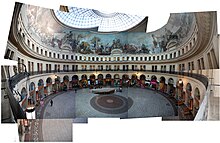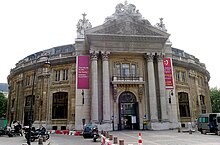Bourse de commerce (Paris)
The Bourse de commerce in Paris is a rotunda from the 18th century, the current state of which is a renovation from the end of the 19th century that served as a commodity exchange . The building in the Rue de Viarmes ( 1st arrondissement ) has been a protected architectural monument ( Monument historique ) since 1975 .
The closest stations to the Paris Métro are Louvre - Rivoli (line 1) and Les Halles (line 4)
history
Grain Market Hall
A Hôtel particulier , the old Hôtel de Nesle (not to be confused with the new Hôtel de Nesle) , stood on the same site as early as the 13th century . The grain market hall ( halle aux blés ) was built on the site of the former Soissons castle . The castle, built in the 17th century under Catherine de Medici, contained a 31 meter tall astronomical column. It was used by the personal astrologer Côme Ruggieri Katharinas for astrological observations.
Since the grain supply of the city was the focus of economists in the 18th century, this location was chosen because of its proximity to the banks of the Seine: the grain trade could be made efficient thanks to the grain ships docking.
The brothers Bernard and Charles Oblin planned to build a large hall, open up the surrounding streets, and build buildings that could be rented to finance the construction. The architect Nicolas Le Camus de Mézières was commissioned to build the hall and the surrounding buildings between 1763 and 1767. Le Camus opted for a ring-shaped building 122 meters in circumference, penetrated by 25 arcades . The interior of the building should not be covered, but two concentric galleries provided a cozy shelter. There was also space for the police, statisticians and the monitoring of weights and measures. On the second floor were huge granaries, roofed with pointed arches made of stone.
The new building was greatly admired. It illustrated the concepts that spread over time: The concept of the stand-alone public building, detached from the urban fabric, which in particular reduced the risk of a fire disaster.
Originally, the Ruggieri astronomical column was to be placed in the center of the building, but this plan had to be discarded. They were content to leave them on the outside of the building, but added a fountain and a sundial designed by the astronomer Guy Pingré .
The open courtyard damaged grain storage. In 1782/83 it was roofed over by a 38 meter high dome by the architects Jacques-Guillaume Legrand and Jacques Molinos , but it was destroyed by fire in 1802. The reconstruction (1806-1811) was carried out by the architect François-Joseph Bélanger and the engineer François Brunet . In 1811, the Cologne architect Jakob Ignaz Hittorff , who had just lived in Paris for a year, acted as his assistant . The new dome was made of iron and covered with copper leaf, which was replaced by windows in 1838. In 1854 another fire ravaged the building.
Paris Stock Exchange
The hall was closed in 1873, handed over to the Chamber of Commerce in 1875 and reopened as a stock exchange in 1888/89 after a renovation by Henri Blondel . The courtyard of the rotunda has been redesigned and the masonry brick was dressed stone covered the region. Since 1975 the dome and the painting are under monument protection . After the extensive restoration in 1989, smaller trade fairs and exhibitions are held in the covered courtyard . The commodity exchange existed until 1998 and was then taken over by Euronext .
On the west side of the rotunda is the monumental portal with four tall, fluted columns and mighty Corinthian capitals . Above it rises a triangular gable , which is crowned by three allegorical figures created by the sculptor Aristide Croisy .
The large covered inner courtyard is adorned with paintings by the painters Alexis-Joseph Mazerolle (1826-1889), Évariste-Vital Luminais (1822-1896), Désiré-François Laugée (1823-1896), Victor Georges Clairin (1843-1919 ) and Hippolyte Lucas (1854–1925). The four cardinal points and the continents are shown.
literature
- Chambre de commerce et d'industrie de Paris (ed.): La bourse de commerce . Paris 2009
Web links
- Bourse de commerce (Paris) Description as Monument historique in the Base Mérimée of the French Ministry of Culture (French text)
Coordinates: 48 ° 51 ′ 45.8 " N , 2 ° 20 ′ 34" E




